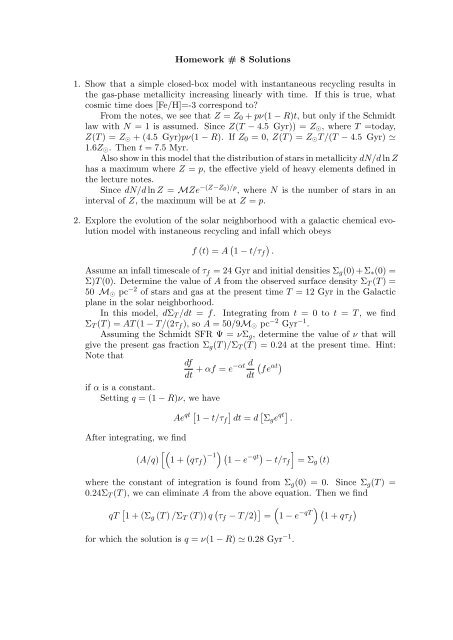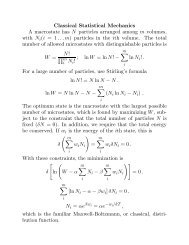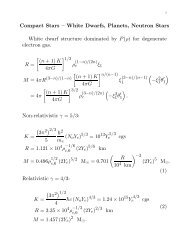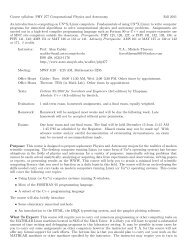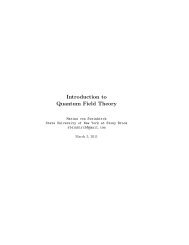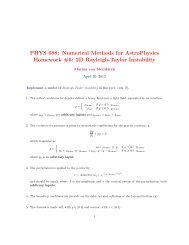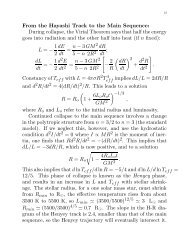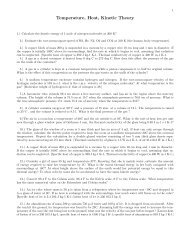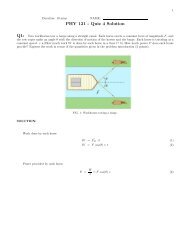Homework # 8 Solutions 1. Show that a simple closed-box model ...
Homework # 8 Solutions 1. Show that a simple closed-box model ...
Homework # 8 Solutions 1. Show that a simple closed-box model ...
Create successful ePaper yourself
Turn your PDF publications into a flip-book with our unique Google optimized e-Paper software.
<strong>Homework</strong> # 8 <strong>Solutions</strong><br />
<strong>1.</strong> <strong>Show</strong> <strong>that</strong> a <strong>simple</strong> <strong>closed</strong>-<strong>box</strong> <strong>model</strong> with instantaneous recycling results in<br />
the gas-phase metallicity increasing linearly with time. If this is true, what<br />
cosmic time does [Fe/H]=-3 correspond to<br />
From the notes, we see <strong>that</strong> Z = Z 0 + pν(1 − R)t, but only if the Schmidt<br />
law with N = 1 is assumed. Since Z(T − 4.5 Gyr)) = Z ⊙ , where T =today,<br />
Z(T ) = Z ⊙ + (4.5 Gyr)pν(1 − R). If Z 0 = 0, Z(T ) = Z ⊙ T/(T − 4.5 Gyr) ≃<br />
<strong>1.</strong>6Z ⊙ . Then t = 7.5 Myr.<br />
Also show in this <strong>model</strong> <strong>that</strong> the distribution of stars in metallicity dN/d ln Z<br />
has a maximum where Z = p, the effective yield of heavy elements defined in<br />
the lecture notes.<br />
Since dN/d ln Z = MZe −(Z−Z 0)/p , where N is the number of stars in an<br />
interval of Z, the maximum will be at Z = p.<br />
2. Explore the evolution of the solar neighborhood with a galactic chemical evolution<br />
<strong>model</strong> with instaneous recycling and infall which obeys<br />
f (t) = A ( 1 − t/τ f<br />
)<br />
.<br />
Assume an infall timescale of τ f = 24 Gyr and initial densities Σ g (0) + Σ ∗ (0) =<br />
Σ)T (0). Determine the value of A from the observed surface density Σ T (T ) =<br />
50 M ⊙ pc −2 of stars and gas at the present time T = 12 Gyr in the Galactic<br />
plane in the solar neighborhood.<br />
In this <strong>model</strong>, dΣ T /dt = f. Integrating from t = 0 to t = T , we find<br />
Σ T (T ) = AT (1 − T/(2τ f ), so A = 50/9M ⊙ pc −2 Gyr −1 .<br />
Assuming the Schmidt SFR Ψ = νΣ g , determine the value of ν <strong>that</strong> will<br />
give the present gas fraction Σ g (T )/Σ T (T ) = 0.24 at the present time. Hint:<br />
Note <strong>that</strong><br />
df<br />
dt + αf = d ( e−αt fe<br />
αt )<br />
dt<br />
if α is a constant.<br />
Setting q = (1 − R)ν, we have<br />
Ae qt [ 1 − t/τ f<br />
]<br />
dt = d<br />
[<br />
Σg e qt] .<br />
After integrating, we find<br />
(A/q)<br />
[(1 + ( ) ) −1 (1<br />
qτ f − e<br />
−qt ) ]<br />
− t/τ f = Σ g (t)<br />
where the constant of integration is found from Σ g (0) = 0. Since Σ g (T ) =<br />
0.24Σ T (T ), we can eliminate A from the above equation. Then we find<br />
qT [ 1 + (Σ g (T ) /Σ T (T )) q ( τ f − T/2 )] =<br />
(1 ) − e −qT ( )<br />
1 + qτf<br />
for which the solution is q = ν(1 − R) ≃ 0.28 Gyr −1 .
3. Explain why the value of [O/Fe] observed in stars is both greater than 0 and<br />
does not vary with [Fe/H] for metal-deficient stars for [Fe/H]< −<strong>1.</strong>5, but decreases<br />
with increasing metallicity for more metal-rich stars. When [Fe/H]=0,<br />
what value should [O/Fe] have<br />
At low metallicities, all O and Fe is produced by type II supernovae and is<br />
therefore roughly constant. However, at later times than [Fe/H]=-<strong>1.</strong>5, Type I<br />
supernovae contribute Fe but no O, so O/Fe decreases. When the iron abundance<br />
is solar, the oxygen abundance should also be solar.<br />
4. Do problem 4.13 in the text.<br />
The equations described, setting e = 1, are<br />
√<br />
r = a (1 − cos η) , t = a 3 / [G (M + m)] (η − sin η) ,<br />
dr/dt = (r/t) sin η (η − sin η) / (1 − cos η) 2 .<br />
Using r = 770 kpc, t = 12.8 Gyr and v = −120 km s −1 , one finds η ∼ 4.2, a =<br />
520 kpc and M + m ∼ 5 × 10 12 M ⊙ .<br />
The two galaxies will again come close together when η = 2π or<br />
√<br />
t = 2π a 3 / [G (M + m)] ≃ 16 Gyr.<br />
Since now was assumed to be 12.8 Gyr, this is 3.2 Gyr from now.<br />
One has to add up the luminosities for the Local Group galaxies, about<br />
5.1 × 10 10 L ⊙ . Then the mass-to-light ratio about 100.<br />
With the new value of η and given values of r and dr/dt, one can compute<br />
a new value of t which turns out to be larger. With the new eta and given r,<br />
you recompute the value of a which also becomes larger. Then use the equation<br />
for t to compute the new value of the total mass, which turns out to become<br />
smaller.


